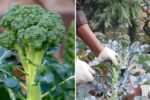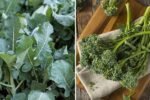Once prized across Africa for its healing properties and robust flavor, bitterleaf (Vernonia amygdalina) is now finding a home in American kitchens and gardens. This remarkable green vegetable, known for its distinct bitter taste and incredible health benefits, is emerging as one of the most exciting superfoods in America’s growing wellness and farm-to-table movement.
Whether you call it bitterleaf, ewuro, onugbu, or South African spinach, this powerhouse plant is capturing attention for its versatility, nutritional value, and cultural significance. As more Americans explore global cuisines and embrace plant-based eating, bitterleaf is becoming a must-try green—offering both medicinal power and culinary potential.
In this detailed guide, we’ll explore what makes bitterleaf so special, how to grow it in the U.S., its impressive health benefits, and how to prepare delicious dishes that celebrate its bold flavor.
1. What Is Bitterleaf?

Bitterleaf is a leafy green vegetable native to tropical Africa, particularly popular in Nigeria, Cameroon, Ghana, and Kenya. Scientifically known as Vernonia amygdalina, it gets its name from its naturally bitter flavor, which comes from beneficial plant compounds known as alkaloids and flavonoids.
In African homes, bitterleaf is much more than just food—it’s medicine, culture, and tradition. It’s used to make beloved dishes like bitterleaf soup (Ofe Onugbu) and Ndole, both celebrated for their rich, earthy taste and nourishing quality.
Today, bitterleaf is spreading across the world, with African immigrants cultivating it in America and introducing it to local farmers’ markets, health food stores, and home gardens. Gardeners in Florida, Texas, and Southern California are especially embracing it for its resilience, quick growth, and nutritional benefits.
2. The Nutritional Powerhouse: Why Bitterleaf Is a Super Green

Behind its sharp taste lies a treasure chest of nutrients. Bitterleaf is a low-calorie, high-fiber green loaded with essential vitamins and minerals. Here’s a look at what makes it a true superfood for American diets:
a. Rich in Vitamins and Minerals
Bitterleaf is packed with:
- Vitamin A – Supports healthy eyesight and skin
- Vitamin C – Boosts immunity and collagen production
- Vitamin E – Fights oxidative stress and promotes cell health
- Iron and Zinc – Support blood health and metabolism
- Calcium and Potassium – Strengthen bones and regulate blood pressure
b. High in Antioxidants
Bitterleaf is loaded with flavonoids, saponins, and polyphenols—natural antioxidants that protect the body from free radicals and reduce inflammation.
c. Supports Healthy Blood Sugar Levels
Studies suggest bitterleaf can help regulate blood glucose and may benefit those managing diabetes when included in a balanced diet.
d. Aids Digestion and Detoxification
The plant’s mild bitterness stimulates digestive enzymes and supports liver function, helping the body naturally detoxify.
e. Boosts Immunity and Energy
Thanks to its iron and vitamin content, bitterleaf promotes blood circulation, boosts energy levels, and strengthens immune response.
Bitterleaf’s combination of taste, texture, and therapeutic value makes it one of the most underappreciated yet powerful greens Americans can add to their diet.
3. How to Grow Bitterleaf in the U.S.

Good news for green thumbs—bitterleaf is incredibly easy to grow, especially in warm American climates. It’s hardy, drought-tolerant, and thrives in tropical to subtropical conditions, making it perfect for southern states.
a. Climate and Location
- Ideal Temperature: 70°F to 90°F
- Sunlight: Full sun to partial shade
- Zones: USDA Zones 8–11 (Florida, Texas, Louisiana, Southern California, Georgia)
b. Soil Requirements
Bitterleaf grows best in loamy, well-drained soil enriched with organic matter. The pH should be slightly acidic to neutral (6.0–7.0).
c. Planting
You can propagate bitterleaf using stem cuttings or seeds:
- For cuttings: Choose a mature stem about 6–8 inches long, remove the lower leaves, and plant directly in moist soil.
- For seeds: Sow directly in soil or start in trays indoors. Keep the soil consistently damp until germination.
d. Watering and Care
Water regularly to maintain slightly moist soil. Bitterleaf can withstand short dry spells but thrives with consistent moisture. Prune occasionally to encourage bushier growth.
e. Harvesting
Leaves can be harvested two to three months after planting. Cut the young, tender leaves for cooking. Regular pruning also stimulates continuous growth throughout the year.
Tip: Always wash and blanch the leaves before cooking to reduce bitterness (unless you enjoy it strong!).
4. How to Prepare and Cook Bitterleaf

The key to enjoying bitterleaf lies in preparation. Its natural bitterness can be reduced—or embraced—depending on your taste.
a. How to Wash Bitterleaf
Traditionally, the leaves are washed and squeezed multiple times in clean water to remove excess bitterness. You can also boil them briefly and drain the water before using them in recipes.
b. Cooking Methods
Bitterleaf can be used in soups, stews, and sautés. Its texture softens beautifully when cooked, making it a great addition to flavorful dishes. Here are some popular and creative ways to enjoy it:
1. Nigerian Bitterleaf Soup (Ofe Onugbu)
A hearty West African favorite made with bitterleaf, cocoyam paste, palm oil, and meats or fish. The blend of spices and earthy flavors makes it deeply satisfying and nutritious.
2. Cameroonian Ndole
A rich, creamy stew made from blanched bitterleaf, ground peanuts, and shrimp or beef. It’s a perfect introduction for those new to this green.
3. Bitterleaf and Spinach Stir-Fry
Mix bitterleaf with spinach, garlic, onions, and olive oil for a quick, healthy American twist. Serve it with quinoa, rice, or roasted potatoes.
4. Bitterleaf Smoothie (for the Brave!)
Blend a few blanched bitterleaf leaves with pineapple, ginger, and lemon. The sweetness of the fruit balances the bitterness and delivers a powerhouse of antioxidants.
5. Bitterleaf Soup with Lentils
A plant-based comfort meal: cook lentils with onions, tomatoes, and spices, then stir in chopped bitterleaf for a hearty, fiber-rich soup.
No matter the dish, bitterleaf adds a distinctive edge that transforms everyday meals into something bold and memorable.
5. Bitterleaf in Modern American Wellness Trends

As Americans become more conscious of natural remedies and holistic nutrition, bitterleaf is finding a special place in wellness circles. Its detoxifying and anti-inflammatory properties make it popular among those pursuing clean eating, vegan diets, and herbal medicine.
Here’s why bitterleaf is trending in the U.S.:
- Functional Food: It’s seen as both nourishment and natural medicine.
- Cultural Exchange: Immigrant communities are introducing bitterleaf to new audiences through pop-up markets, farm cooperatives, and restaurants.
- Sustainability: Bitterleaf grows quickly, requires little fertilizer, and adapts easily to different environments—making it a sustainable addition to American home gardens.
In fact, small-scale farms in Florida, California, and Texas are beginning to cultivate bitterleaf commercially for specialty produce markets. It’s also being studied for its potential in herbal supplements and teas, signaling a bright future in the American health industry.
6. Health and Medicinal Uses of Bitterleaf
Beyond its culinary uses, bitterleaf has been used in traditional medicine for centuries. Modern research supports many of these applications:
- Liver Cleanse: Bitterleaf extract supports liver detoxification and helps prevent fatty liver buildup.
- Immune Support: Its antioxidants and vitamins strengthen the immune system.
- Blood Sugar Regulation: May assist in lowering blood glucose and supporting insulin sensitivity.
- Anti-inflammatory Properties: Helps relieve inflammation and joint pain naturally.
- Digestive Health: Encourages better digestion and relieves constipation.
While more scientific research is ongoing, bitterleaf’s long history of use highlights its potential role in natural healing and preventive health.
7. Growing Popularity in American Cuisine
Chefs across the United States are incorporating bitterleaf into creative dishes—adding it to grain bowls, vegetable stews, and green juices. Its slightly bitter note is being celebrated as a “flavor enhancer” that balances rich, sweet, or spicy components.
In plant-based restaurants and African fusion eateries, you’ll find innovative takes like:
- Bitterleaf pesto with roasted nuts
- Bitterleaf veggie wraps
- Bitterleaf hummus dips
Its adaptability and nutrient density make it a favorite among vegan chefs and nutrition-conscious Americans looking to expand their green repertoire beyond kale and collards.
8. Final Thoughts: Bitterleaf—A Bold Green for America’s Future
Bitterleaf may not be as well-known as spinach or kale—yet—but it’s quickly earning its place as one of America’s most promising supergreens. Its strong flavor, healing properties, and sustainability make it more than just another leafy vegetable; it’s a symbol of global connection, resilience, and natural wellness.
Whether you’re a home gardener, a health enthusiast, or a curious cook, bitterleaf offers something truly special. From its medicinal uses to its vibrant recipes, it’s a plant that nourishes body, soul, and soil alike.
So, the next time you’re looking for a new green to grow or cook, give bitterleaf a try. It’s bold, beautiful, and bursting with benefits—a true gift from nature, now thriving in American soil.





